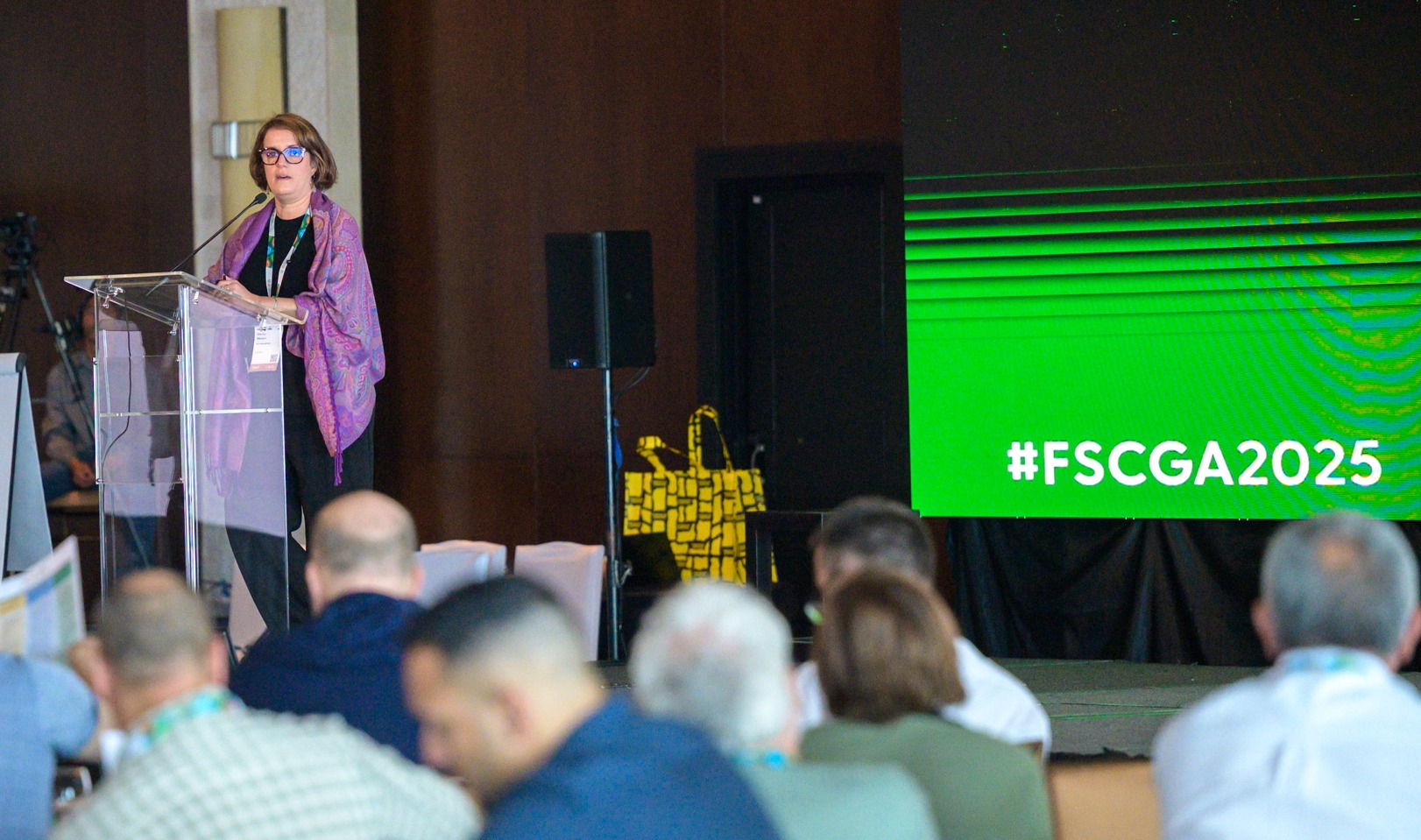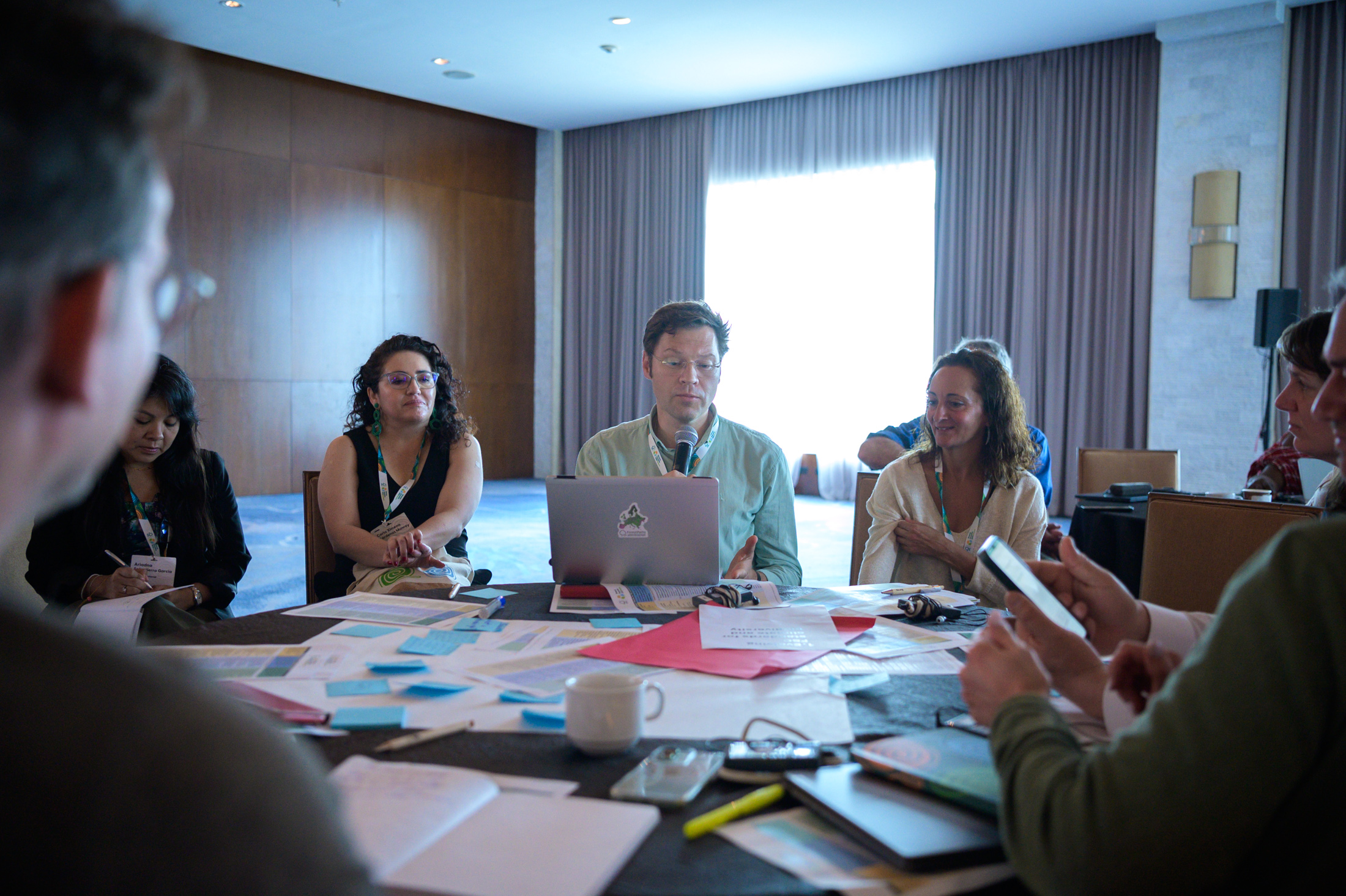Setting the tone – urgency and opportunity
Amanda Carvalho de Andrade, member of the FSC International Board of Directors, opened the session by reminding participants of the urgency and scale of the challenge facing humanity.
“This is a long-coming crisis, and it gives me goosebumps just thinking about it, she said, reflecting on the gravity of both the climate and biodiversity crises. She noted that, while FSC members and staff have long been aware of the issue, “we as FSC have not been so intentional and so verbal and so strategic about this issue.” Andrade reminded participants that in 2024, the Board made the development of the Climate and Biodiversity Framework a priority, building on FSC’s global strategy and motions passed previously.
“We acknowledge the delays, but here we are now,” she continued. “The design is just finishing up — but the implementation absolutely starts now.”
After extensive groundwork, the Climate and Biodiversity Strategic Framework will be up for Board approval in December.

María Pilar Melero Bravo, who leads the development of the framework, explained its dual purpose: “One is to articulate what is the role of FSC addressing the climate and biodiversity crisis. And on the other hand, also to serve as the guide for the development and solutions.” She described the broad consultative process behind the framework: extensive desk reviews, interviews and workshops with the Board, the Permanent Indigenous Peoples Committee and international teams, followed by two consultation rounds.
“We received more than 250 participations through different channels,” she said.
“The overall feedback is: yes, it’s a good start but it needs to be more focused, clearer, simpler.”
She highlighted that the framework will rest on three strategic areas: Promoting forest management practices that contribute to climate and biodiversity goals, leveraging markets and finance to reward responsible practices and support restoration, and advancing policy and partnerships to position forests as key climate and biodiversity solutions.
Then Mike Bekin, long-term FSC member and proposer of the only two climate-focused motions passed at a General Assembly, Underscored the opportunity ahead. “I’ve been working with this topic for almost ten years,” he said. “In my view, climate change represents the biggest opportunity for FSC to be relevant again. We need a big old vision - there’s a lot of demand in the world for solutions.”
Time for debate
After the presentations, participants spread across 15 thematic tables to explore practical solutions and pain points. At the standards tables, participants proposed a two-tier approach to climate-resilient forest management — a baseline applicable to all certificate holders, and a second tier for country-specific adaptation and mitigation. Several stressed the importance of “comprehensive analysis of the causes of the problem” and the need for “local adaptation strategies.”
The risk and adaptation group called for regional guidance and better communication tools. One suggestion: to develop consumer-facing transparency, such as a QR code on FSC-labelled products that shows what climate measures a forest manager has taken.
In the data and technology discussion, participants agreed FSC must clearly define its goal: “Is it global proof of the impact of FSC or local improvement of standards?” one asked. The group agreed on the need for a clear data structure and raised a practical question: if data collection becomes mandatory, “who pays for the cost?”
The markets and finance table brought a strong field perspective. “All of FSC’s objectives happen on the ground,” said one forest manager. “Practices that protect forests are costly and time-consuming, and right now there’s not a lot of reward for doing them.” The group called for clearer links between financial mechanisms and forest stewards, ensuring climate finance actually reaches those implementing sustainable management.
At the integrity table, participants discussed FSC’s potential to strengthen the credibility of emerging climate and biodiversity markets. “FSC could offer its assurance systems to support reporting frameworks that currently lack verification,” one contributor noted, calling it “an opportunity to bring the integrity of FSC’s system into broader climate reporting.”
Other discussions focused on government engagement, science and innovation, and governance. The government policy group urged closer collaboration with national and regional authorities and suggested hiring additional policy expertise within the FSC network.
The science and innovation group called for long-term research partnerships and data-sharing frameworks to make FSC a hub for credible science. Meanwhile, the governance and transparency group underlined the need for accessible, scalable monitoring systems to ensure credibility and comparability across regions.
Closing message from Subhra Bhattacharjee
The session closed with reflections from Subhra Bhattacharjee, Director General of FSC International, who tied the threads together. She thanked participants for their engagement and emphasised that clarity of purpose, strong partnerships, and practical feasibility must guide FSC’s next steps.
“Demonstrating impact and making impact must go hand in hand,” she said. “Unless we can show what already works on the ground, we cannot ask certificate holders to take on more — nor unlock the climate finance that smallholders and communities need.”
She added that adaptation and mitigation should not be treated as separate silos: “In forests, what is adaptive often helps with mitigation, and what is mitigative strengthens resilience. Our strategy must build on these connections, not divide them.”
Her closing message was clear: this was only the beginning. The consultation remains open, and the discussion will continue at the GA Open House and in the joint session linking the Climate and Biodiversity Framework, Global Strategy, and Principles & Criteria revision. As Shubra concluded, “This conversation is just the beginning — but it will shape how FSC contributes to climate action for years to come.”


